Many family crests have their roots in patterns such as “Japanese Wisteria(藤/Fuji)” and “Plum(梅/ume)”, which were used for clothing, furnishings and building interiors among the privileged classes from ancient times.
The arrowhead pattern(沢瀉文/Omodaka mon) introduced here is one such pattern, which seems to have already been used in the Nara period (710-794).
Arrowhead(沢瀉/Omodaka) is a plant with pretty three-petalled white flowers from summer to autumn, and it seems to have been popular as one of the representative patterns of early summer.
In fact, it is not clear why arrowhead(沢瀉/Omodaka) became a representative early summer motif.
As an example of the use of arrowhead(沢瀉/Omodaka) as a coat of arms, records show that in the Heian period it was used on an ox carriage owned by the Koga family(久我家/Koga ke), the head family of the Murakami Genji(村上源氏) clan and a member of the Seika family(清華家/Seika ke).
Furthermore, the arrowhead pattern(沢瀉文/Omodaka mon) was also used as a family crest by many famous warring feudal lords and generals because of its auspiciousness.
We would like to introduce you to the arrowhead pattern(沢瀉文/Omodaka mon), which has been loved for centuries!
About Arrowhead(沢瀉/Omodaka)?
 Arrowhead(沢瀉/Omodaka) is a perennial aquatic plant in the family Omodidae.
Arrowhead(沢瀉/Omodaka) is a perennial aquatic plant in the family Omodidae.
As an aquatic plant, it occurs in wetlands, swamps, reservoirs and rice paddies. When it reaches a certain stage of growth, it bears distinctive leaves. Its leaves are arrowhead-shaped and have long, 30-60 cm long stems. From summer to autumn, it grows 40-70 cm tall flower stalks with white, three-petalled flowers in a ring.
Its distinctive leaves and pretty white flowers are sometimes used for ornamental purposes.
However, in the past, when Japanese people were familiar with rice cultivation, arrowhead(沢瀉/Omodaka) was considered a troublesome weed because it was not an annual but a perennial plant that also occurred in rice paddies, making herbicides ineffective.
Therefore, like other perennial weeds, the arrowhead(沢瀉/Omodaka) germinates not only from seeds but also from tubers, which are developed underground stems, so that even if it fails to produce seeds and the above-ground parts disappear, new above-ground parts will arise from underground the following year.
Strong roots ^^!
This makes it difficult to eradicate arrowhead(沢瀉/Omodaka) by methods such as weeding, which often gives the impression that it is “stubborn”.
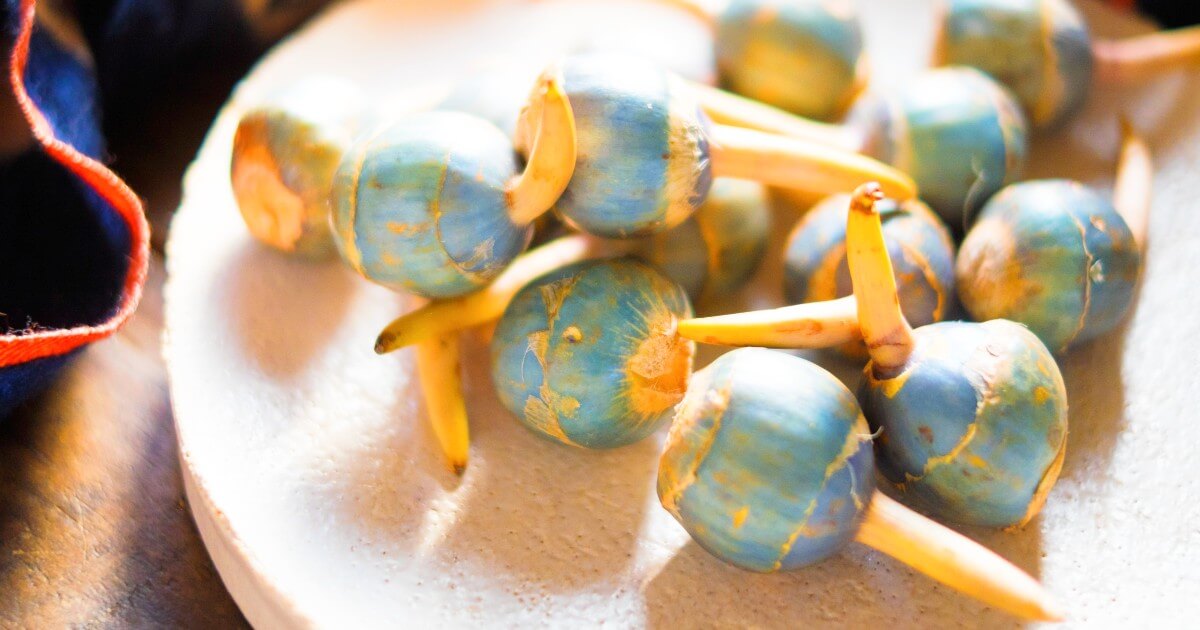 The kuwai used in Kyoto vegetables and Osechi dishes(Japanese traditional foods which are eaten by a lot of Japanese on New Year’s Day) is the “tuber” part of the arrowhead(沢瀉/Omodaka), a cultivated variety of this plant. The tuber is, to put it simply, a potato or a konjac potato.
The kuwai used in Kyoto vegetables and Osechi dishes(Japanese traditional foods which are eaten by a lot of Japanese on New Year’s Day) is the “tuber” part of the arrowhead(沢瀉/Omodaka), a cultivated variety of this plant. The tuber is, to put it simply, a potato or a konjac potato.
Arrowhead(沢瀉/Omodaka) is still popular as a lucky foodstuff that “sprouts (eyes)” from the appearance of sprouts growing out of the round tuber part of the arrowhead(沢瀉/Omodaka), and is an indispensable vegetable in Osechi dishes(Japanese traditional foods which are eaten by a lot of Japanese on New Year’s Day).
About arrowhead pattern(沢瀉文/Omodaka mon)
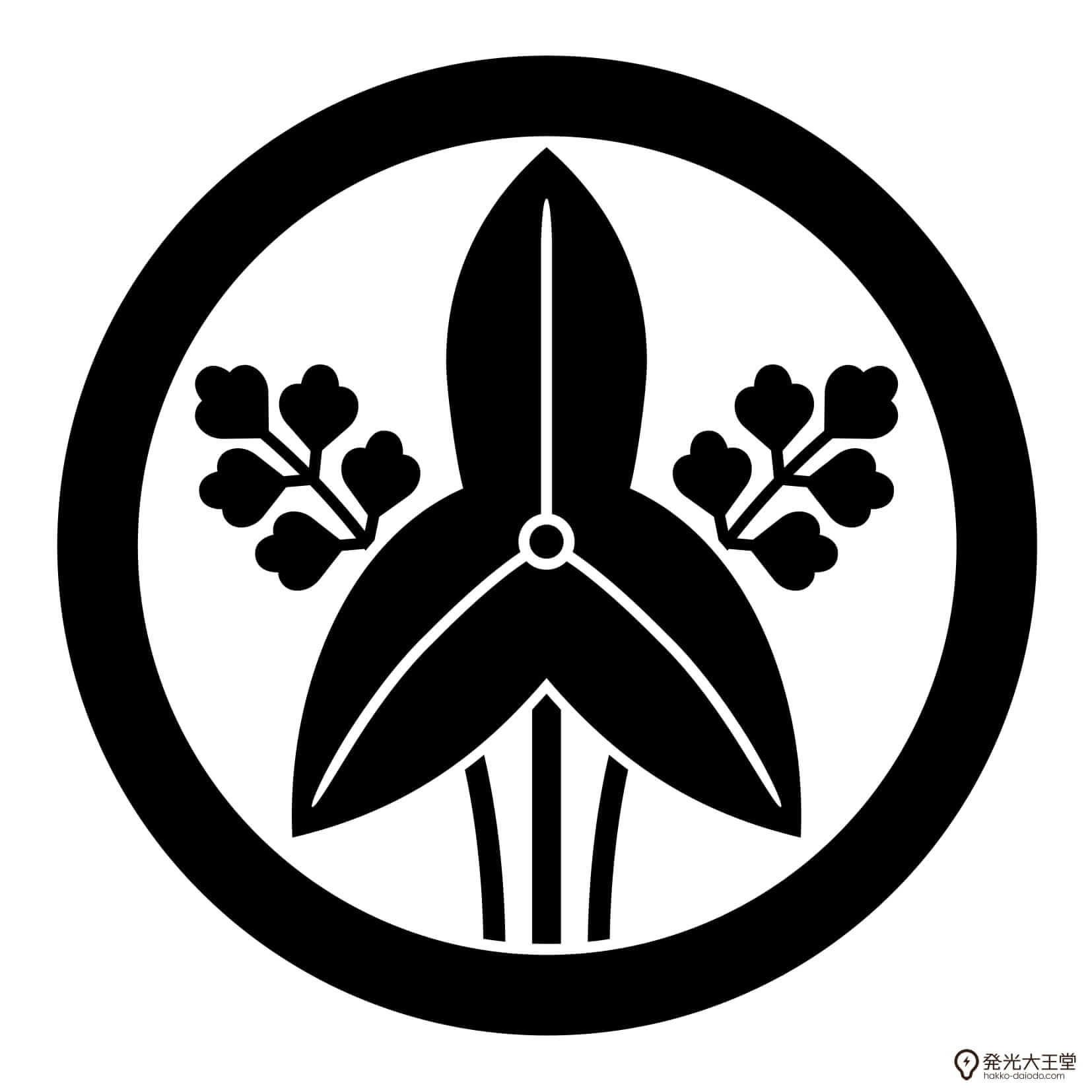 Family crest: Maru ni tachi oodaka (丸に立ち沢瀉)
Family crest: Maru ni tachi oodaka (丸に立ち沢瀉)
Photo:フリー素材サイト発光大王堂
Maru ni tachi omodaka(arrowhead with standing phlegm in a circle/丸に立ち沢瀉) is a type of arrowhead pattern(沢瀉文/Omodaka mon). arrowhead pattern(沢瀉文/Omodaka mon) is so widespread that it is counted as one of the ten major crests, and it is a very popular crest genus with many families using it even today.
Arrowhead pattern(沢瀉文/Omodaka mon) is a type of botanical pattern based on the motif of arrowhead(沢瀉/Omodaka).
The leaves of the omodaka plant have a rather distinctive shape, and because the shape of the leaves resembles the arrowhead of an arrow, they were also known as ‘kachiikusa’ (meaning ‘victory grass’) and were regarded as a good-luck charm, especially by the warrior class.
Furthermore, as mentioned above, kuwai, which has been used as a traditional foodstuff, was treated as a good-luck vegetable because of its ‘sprouting (eyes)’ appearance, and some samurai families, who were attracted by its ‘stubbornness’ that could not be eradicated, began to use the arrowhead pattern(沢瀉文/Omodaka mon) as their family crest.
Famous warring lords and generals with arrowhead pattern(沢瀉文/Omodaka mon)
Toyotomi Hidetsugu and Daki omodaka
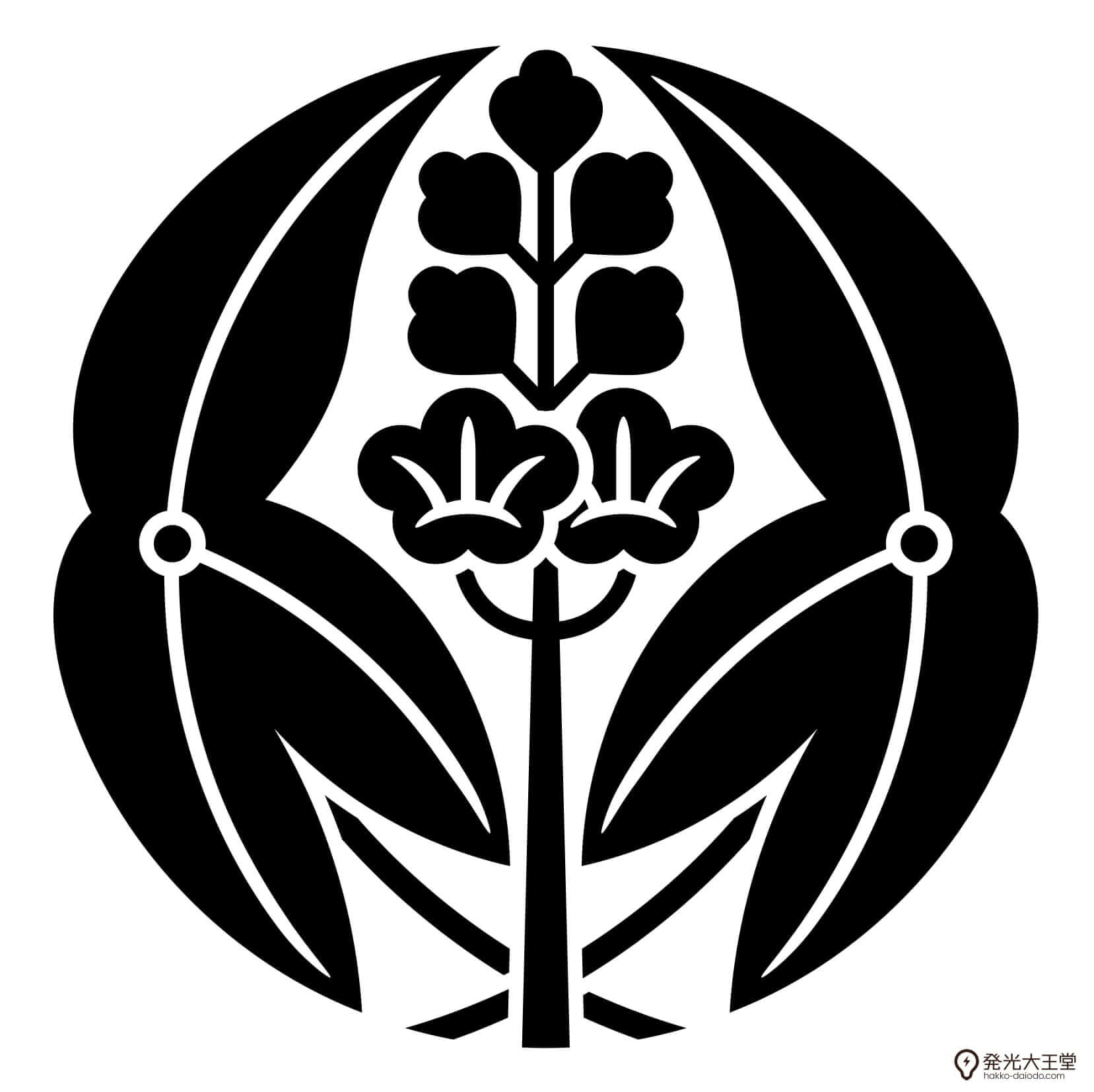
Family crest: Daki omodak(抱き沢潟)
Photo:フリー素材サイト発光大王堂
Toyotomi Hidetsugu(豊臣 秀次) was a nephew of Toyotomi Hideyoshi(豊臣 秀吉), who adopted him and made him his successor.
After the birth of Toyotomi Hideyori(豊臣 秀頼), his relationship with Hideyoshi deteriorated and he was banished to Koyasan(高野山) in 1595 (Bunroku 4), after which he is said to have committed seppuku(切腹/Harakiri or seppuku is a form of ritual suicide performed by cutting open the abdomen.)
Toyotomi Hidetsugu seems to have used the arrowhead crest(沢瀉紋/omodaka mon) on his banner or horse seal.
The type is daki omodaka(抱き沢瀉).
Incidentally, Toyotomi Hideyoshi seems to have used the “arrowhead crest(沢瀉紋/omodaka mon)” until he was given the “Gosan no Kiri crest(五三の桐紋/A type of plant crest with a “Empress Tree” motif.)” by Oda Nobunaga(織田 信長), when he took the name “Kinoshita Tokichiro(木下藤吉郎)”.
The reason for this seems to be a connection with the Asano clan(浅野氏), whose daughter Nene, Hideyoshi’s wife, had been adopted in the past.
Fukushima Masanori and Fukushima Omodaka

Family crest: Fukushima Omodaka(福島沢瀉)
Photo:フリー素材サイト発光大王堂
Fukushima Masanori(福島 正則) was a vassal of Toyotomi Hideyoshi, a brave and daring “Budan ha(武断派/Persons in a position to attempt to conduct politics by force.)” military commander.
He was a feudal lord of 510,000 goku after his military exploits in the Battle of Shizugatake(賤ヶ岳の戦い), the Battle of Odawara(小田原の役), the Korean Invasion(朝鮮出兵) and the Battle of Sekigahara(関ヶ原の戦い).
He was also known as “a wild boar warrior, skilled in valour, but a drunkard and lacking in wisdom”.
It is also called “Fukushima Omodaka Mon(福島沢瀉文)”, partly after the name of Fukushima Masanori, one of the generals to whom Hideyoshi gave the arrowhead pattern(沢瀉文/Omodaka mon), and who used it to the end.
Mori Motonari and Nagato Omodaka
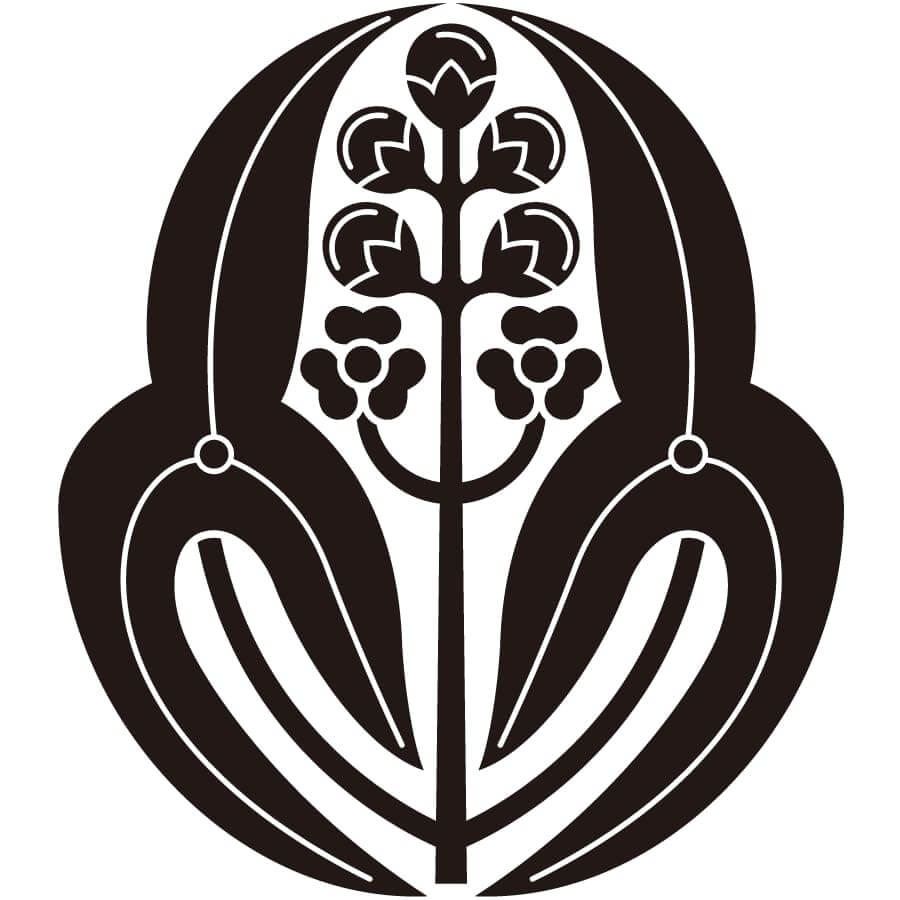
Family crest: Nagato Omodaka(長門沢瀉)
Photo:家紋のいろは
Mori Motonari(毛利元就), famous for establishing control of eight countries in the Chugoku region(中国地方) in his lifetime from the position of a small provincial lord, inspired the morale of his men by having dragonflies, known as “victory insects(勝ち虫/katchi mushi)”, perch on the arrowhead(沢瀉/Omodaka), another name for “victory grass(勝い草/kachi ikusa)”, and actually winning battles. The family crest is said to have been associated with this event, which led to the use of the arrowhead crest(沢瀉紋/omodaka mon) [though it is said to have been used as a backwards design].
The type is Nagato Omodaka(長門沢瀉).
Incidentally, the dragonfly is called “victory insects(勝ち虫/katchi mushi)” because of its habit of never flying backwards, which is thought to be connected with “never retreating”, another kind of good luck charm.
History of arrowhead(沢瀉/Omodaka)
The arrowhead pattern(沢瀉文/Omodaka mon) has been widely used by samurai families because of its auspicious connotations as a family crest.
Arrowhead pattern(沢瀉文/Omodaka mon) has been popular as a kind of pattern since the Nara period (710-794), and during the Genpei wars(源平争乱/Genpei no souran) in the late Heian period (794-1185), records show that the arrowhead pattern(沢瀉文/Omodaka mon) was used on the hidatare(武士の直垂) of samurai warriors.
Also, as the generals on the Genji side used the large armour(源氏鎧の縅/Genji yoroi no odoshi) called Omodaka Odoshi(沢瀉縅), in which a design of arrowhead(沢瀉/Omodaka) was expressed by using several different coloured threads in the odoshi part of the Genji armour(源氏鎧の縅/Genji yoroi no odoshi), the arrowhead pattern(沢瀉文/Omodaka mon) gradually became established as one of the patterns used by the warrior class.
There are records from the mid-Muromachi period (1333-1573 CE) of warlords using the arrowhead pattern(沢瀉文/Omodaka mon) as a crest to represent the family, rather than as a mere pattern.
During the turbulent Warring States period(戦国時代/Sengoku jidai), with the rise of various large and small samurai powers, large-scale battles began to occur more frequently, and the importance of the coat of arms that represented the family increased. The importance of the family crest became more and more important, and several warrior families began to use the arrowhead crest(沢瀉文/Omodaka mon) because of its auspicious connotations.
See also above ^^.
With this military significance, the arrowhead crest(沢瀉文/Omodaka mon) seems to have been used as a family crest by various warrior families, both large and small, along with the Taka no ha crest(鷹の羽紋/Taka no ha mon) and Ken katabami crest(剣片喰紋/Ken katabami mon).
When the Edo shogunate (1603-1867/江戸幕府/Edo bakufu) was established and the era of peace arrived, the family crest spread explosively not only to the privileged classes but also to the general classes. As ordinary people were not allowed to officially use their surnames, they tried to use family crests to distinguish their families.
This meant that every family had to have its own family crest. However, since the family crests were decided on against this background, it seems that most families that decided on a family crest in this period did not have a special meaning for its origin.
Design using arrowhead pattern(沢瀉文/Omodaka mon)
Arrowhead(沢瀉/Omodaka) designs are more often combined with running water than with arrowhead(沢瀉/Omodaka) alone, as arrowhead(沢瀉/Omodaka) grows naturally in wetlands.
The veins of the leaves are emphasised by lines in the unique elongated leaves, and some designs include small flowers such as wisteria or paulownia blossoms.
Even today, it is mainly used for summer kimonos(着物) (e.g. yuzen dyeing) and obis(帯).
この投稿をInstagramで見る
この投稿をInstagramで見る
Photo:instagram@echizenyaheita
この投稿をInstagramで見る



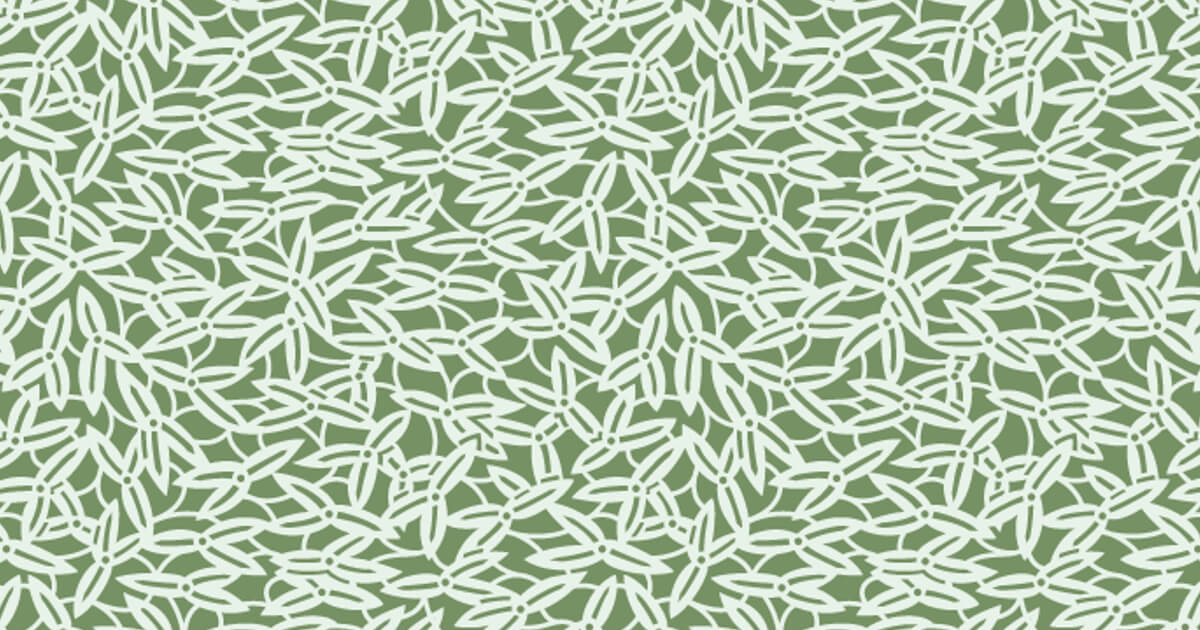


コメント